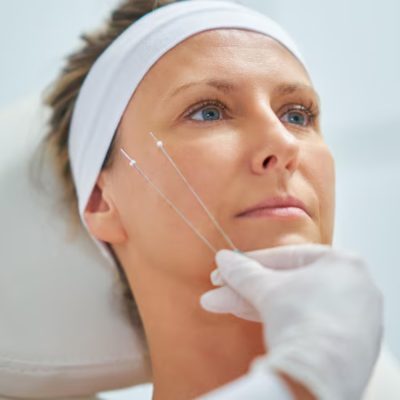Facial Threadlift
Facial threadlifts are a popular non-surgical cosmetic procedure designed to lift and tighten sagging skin on the face and neck. With the use of special threads, it provides an immediate lifting effect while simultaneously stimulating collagen production for longer-lasting results. It is an ideal option for individuals looking to rejuvenate their appearance without surgery.

What is a Facial Threadlift?
Facial threadlifts, also simply referred to as threadlifts are minimally invasive procedures that use dissolvable threads to lift and tighten the skin. These threads are inserted into the deeper layers of the skin, where they act as scaffolding to support the skin and provide an immediate lifting effect. Over time, the threads stimulate collagen production, which enhances skin elasticity and firmness. Hence, they provide a two-way action to provide longer term effects.
Facial threadlifts are suitable for individuals with mild to moderate skin laxity who are looking for a subtle, natural-looking lift without the downtime and risks associated with traditional surgery. The results are immediate and can continue to improve over several months as new collagen forms around the threads.
Method & Treatment of Facial Threadlifts
How Facial Threadlifts Work
The threads used in facial threadlifts are carefully placed under the skin in specific areas using a fine needle or cannula. As the threads are pulled, they lift the skin, providing an instant tightening effect. The threads also encourage the body’s natural healing response, which produces collagen in the treated areas, leading to longer-lasting skin rejuvenation.
Treatment Procedure
Consultation & Skin Assessment
A dermatologist conducts a detailed assessment of the patient’s skin, discuss their aesthetic goals and to determine if a threadlift is the best procedure for them.
Preparation
The treatment area is thoroughly cleaned to prevent infections. A local anaesthetic is used to minimize discomfort during the procedure.
Thread Insertion
Using a thin needle or cannula, the threads are carefully inserted into the targeted areas of the face. The threads are then gently pulled to lift the skin, and any excess thread is trimmed. The threads are designed to be naturally absorbed by the body over time, leaving behind a scaffold of new collagen.
Post-Treatment Care
After the procedure, patients can return to their daily activities with minimal downtime. Some bruising or swelling may occur but usually resolves within a few days.
Applied Areas of Facial Threadlifts
Facial threadlifts can be used on various areas of the face and neck, including:
Cheeks
To lift sagging cheeks and restore a youthful contour.
Jawline
To define the jawline and reduce the appearance of jowls.
Eyebrows
To lift drooping brows and open up the eye area.
Neck
To tighten loose skin and improve neck contours.
Nasolabial Folds & Marionette Lines
To reduce the depth of folds and wrinkles around the mouth.
Precautions and Risks of Facial Threadlifts
Facial threadlifts are generally safe, however, there are some precautions and risks to consider.
- A consultation and evaluation will be done by a qualified dermatologist. This is to determine the suitability of facial threadlifts.
- A thorough medical history review will be done to determine any allergies or medications being taken that may affect the procedure.
- Blood thinners or medications that cause thinning (aspirin or fish oil) must be stopped a few days before the procedure to minimize the risk of bruising.
- Some patients may experience mild discomfort during the procedure, but this is usually managed with local anesthetics.
- Some common side effects include bruising, swelling or mild pain at the insertion points. These typically resolve within a few days.
- In some rare cases, the treads may become visible under the skin, migrate or cause infection. In these cases, it is important to contact the doctor. Also, properly following post-procedural guidelines provided by the doctor should help mitigate these risks.
Post-Procedure Signs to Look Out For
It is important to monitor your skin and follow post-procedure care guidelines. Some of these include:
Bruising & Swelling: Mild bruising and swelling are normal and usually subside within a few days. Applying cold compresses can help reduce these effects.
Tightness or Discomfort: Tightness or mild discomfort is a common side effect, which should improve within a week.
Avoid Excessive Facial Movements: Excessive facial movements like yawning, vigorous chewing or facial massages should be avoided for at least a week post-procedure to allow the threads to settle properly.
Sleeping Position: Sleep on your back with your head elevated for a few nights to minimize pressure on the treated areas.
Avoid Direct Sunlight: Protect your skin from sun exposure and use sunscreen to prevent hyperpigmentation.
Complementary Cosmetic Procedures for Better Outcomes
Facial threadlifts can be combined with other cosmetic treatments to enhance results and achieve a comprehensive facial rejuvenation:
Botox
To relax dynamic wrinkles and complement the lifting effect of threadlifts by smoothing expression lines.
Dermal Fillers
To restore lost volume, enhance facial contours, and further improve the overall aesthetic outcome.
